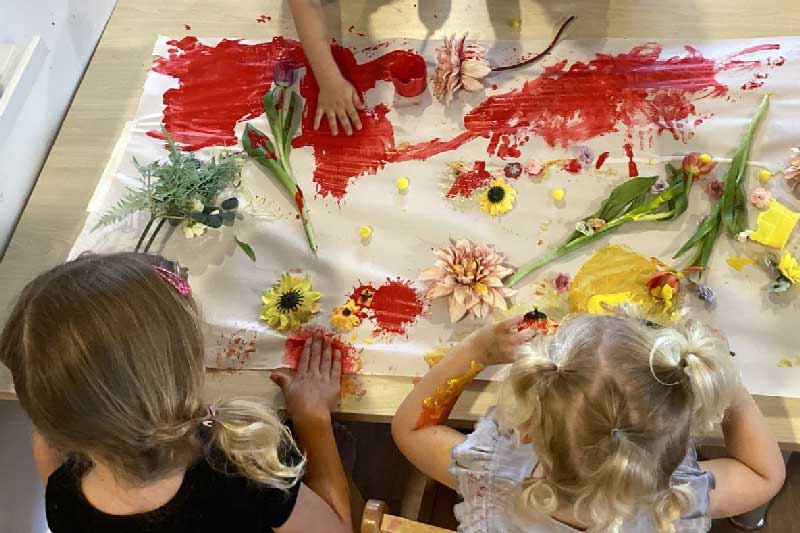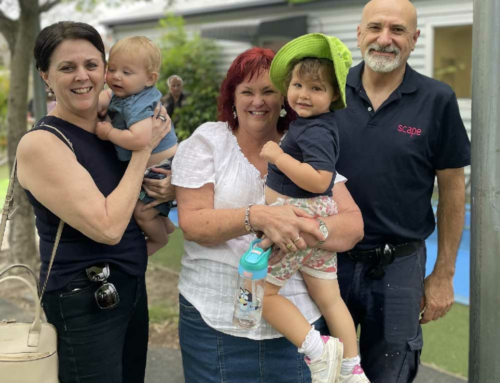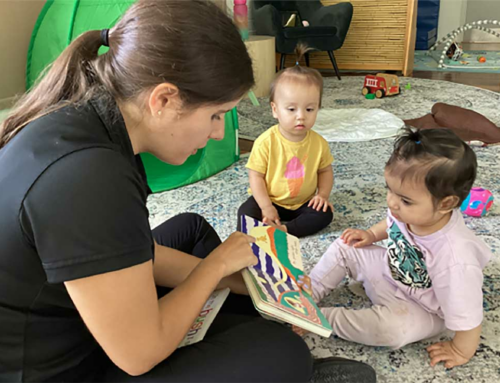Children have so much fun with sensory play. Have you ever noticed how they enjoy getting their hands dirty? From digging in the sand with toy shovels to squishing clay between their fingers – young children are naturally drawn to sensory experiences.
Did you know sensory experiences are enjoyable and can help children learn in various ways? Early childhood education and care services provide so many sensory experiences because they create hours of wonder and endless play opportunities that help children grow and develop.
In this article, we’ll briefly explore the merits of sensory play and list 15 fun sensory activities you can do with your children at home:

What is Sensory Play?
Sensory play is any activity that interacts with a child’s senses. It may involve playing with materials that have different textures, scents, flavours, colours, or noises. Sensory experiences include messy play, sand play, music, water, food and nature play, and more.
Sensory learning is the ability to gather information. During play, children learn by using all their senses – touch, smell, taste, sight, and hearing.
When your child digs their fingers into jelly for the first time, they process all sorts of information, such as how cold it is and how it wobbles and breaks up as they squash it. The act of squashing develops their fine motor skills. They may notice that over time, the jelly’s texture changes as it loses its form and becomes watery, and this is just what they learn through the sense of touch.
Sensory play is an integral part of children’s daily experiences, where the information they gather stimulates cognitive development and exercises motor skills. It’s incredible how much a child can grow and learn while having fun.
In addition, when children engage in sensory play, they learn to explore, experiment, and problem-solve. Next, we discuss the benefits of sensory play.

Sensory play benefits
Some of the advantages of sensory play include:
1. Encourages creativity and imagination
When children engage in sensory play, they can explore and manipulate different materials and textures, stimulating their imagination and creative thinking. Children use their five senses to explore and interact, using their imagination and creativity to solve problems and experiment.
2. Improves fine motor skills
Sensory play helps children develop fine motor skills. It engages their senses and improves hand-eye coordination, finger dexterity, and muscle control. Children who play with sand, water, or playdough explore different textures and materials with their hands. This physical action is good for strengthening the hands’ small muscles.
3. Improves cognitive development
Sensory play is all about playing with different things and using the senses to learn information. It aids in developing nerve connections within the developing brain’s neural pathways. As children learn, they develop cognitive skills such as solving problems, encouraging them to try more complex tasks.
4. Supports language development
It engages multiple senses and encourages communication. Children learn through play with sand, water, and different textures. They describe what they see, feel, hear, and taste. Sensory play can also promote social interaction and turn-taking, encouraging children’s communication.
5. Enhances social interaction
Sensory play improves social interaction. It encourages children to explore and communicate with others. They learn essential skills like sharing and cooperating. Sensory play also helps children regulate their emotions and increase their attention and focus, making it easier for them to engage in social settings.
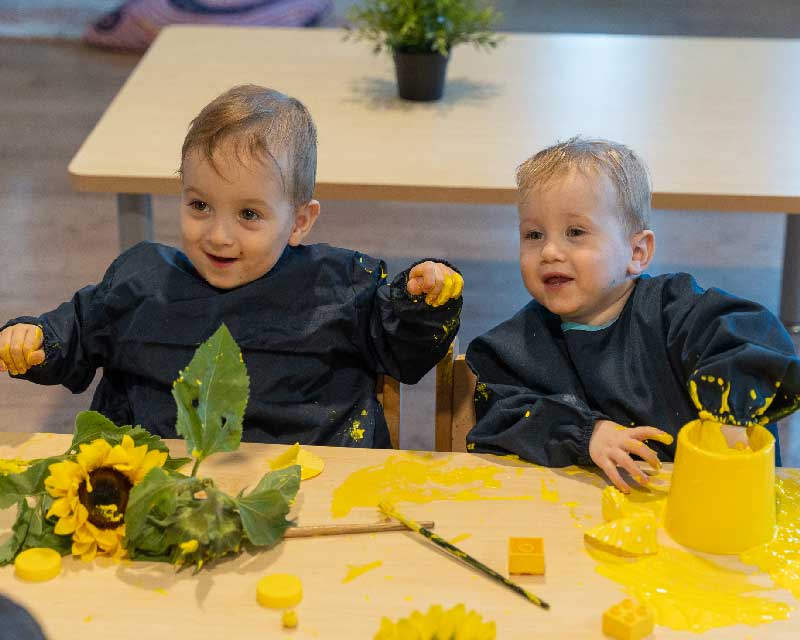
15 Sensory activities
We’ve put together a list of 15 sensory play activities that are easy to do at home:
Simple sensory play ideas for babies
From the moment babies are born, they start experiencing the world around them through their senses. Sensory play is a beautiful way for families and infants to bond.
1. Colourful and textured tummy time
Change up their tummy time aesthetics. Use a colourful play mat one day and a different patterned and coloured mat the next day. You could also try different types of materials and observe how they react.
2. Colourful sensory bag.
Fill a sensory (zip-lock bag) with coloured laminated polka dots and water. Watch as your baby pushes the dots around.
3. Food tasting sensory sensation
Try a food-tasting sensory session if your baby has progressed to solids and is sitting up. Slice up and deseed different citrus fruits like lemons, limes and oranges. Place them in a large bowl with fresh drinking water. Encourage your baby to feel for the various pieces of fruit. When they find one, encourage them to taste it.
4. Rattle bottles
We know that babies like rattles. You can make a rattle using bottles and fill them with different materials like colourful rice, cereal, sand and water. Be sure to secure the lids. You can also use dye to colour the inside material to take this fun playtime activity up a level and explore the sense of sight as well as the sense of hearing.
5. Bath toys
Clean bath toys are an excellent addition to a child’s playtime. When your child can sit up by themselves, add different floating bath toys, including ones that squeak and bob.
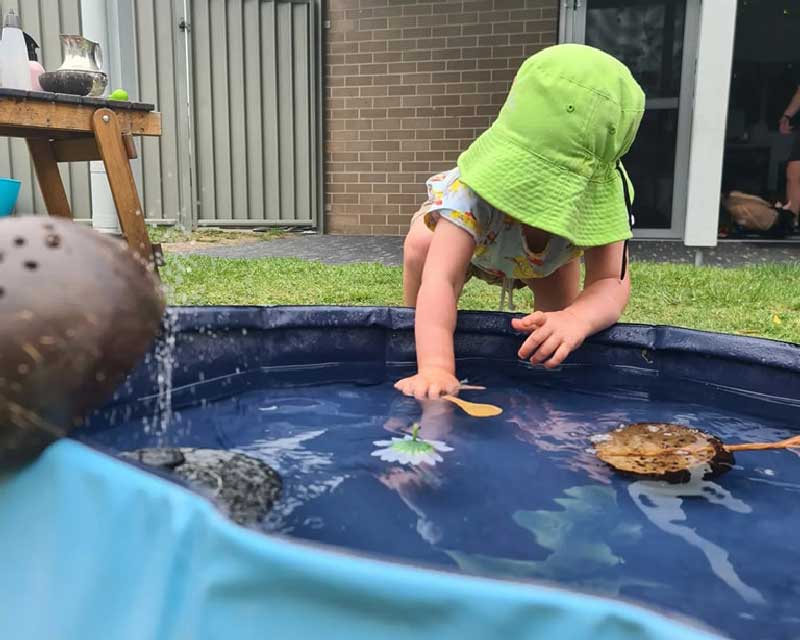
Fun ideas for toddlers
Families, beware! Brace yourself for the whirlwind of chaos with toddlers – their beautiful busy messiness knows no bounds!
6. Playdough that children can smell and eat
What is more fun than playdough? Playdough you can eat! Try one of our three homemade playdough recipes and the scented recipe for a sensory, fun treat.
7. Finger and toe painting
Stick some butcher paper on the ground or wall and allow your child to colour it bright! You could use edible coloured paints such as those used for cake decorations or make your own with ingredients found in most pantries such as cornflower, a cup of boiling water, some cold water and drops of food colouring.
8. Fun activities with jelly
Make up several different coloured sensory ice cube trays of jelly. You could bury clean, safe toys like dinosaurs or farm animals under the jelly for older children to discover. Place the trays of jelly into a large tub and let your child explore and discover. Messy play is a fun sensory play-based experience.
9. Musical instruments
From castanets and drums to chimes and bells, children will delight in playing these instruments and listening to their music as they give their sense of hearing, hands and fingers a workout.
10. Soapy water and foam
This super easy experience requires water, dishwashing soap and a drop of natural food colouring. Mix these in a container with hand-held or electric beaters. It is perfect for indoor or outdoor play, where you and your child can get messy. Add water-themed toys to extend the play.

5 Everyday sensational experiences for preschoolers
These everyday sensory must-haves are much loved for home play by preschoolers.
11. Water play experiences for children
Whether it is raining or just a hot day, outdoor water play is a hit with 4-year-olds. How does the rain feel as it falls from the sky? Are there puddles suitable for jumping in? Can you turn the hose on or fill up buckets to play with in your yard?
12. Sand table
You don’t need a sandpit to incorporate sand play into your child’s day. Fill a baking dish or sizeable clip-lock container with clean sand and place it on a designated sand table where your child can explore the sandy texture. Burry toys in it for them to find or use the sand to draw on.
13. Natural sensory art opportunities for children
Collect natural items from outside, such as flowers, seeds, pine cones, shells, grass, feathers and leaves. Use these to create art with clay or playdough or as nature’s brushes for painting.
14. Quiet sensory sounds
Searching for a calming sensory activity? This experience combines closing your eyes and listening to the sounds around you. What can you and your child hear? Listen for nature sounds like birds, other animals, the wind or the ocean. What human activity sounds can you hear?
15. Taste bud tantalizer
This fun sensory game is perfect for children’s parties or a daily activity at home. Children participate by being blindfolded. Next, they taste-test different foods to see if they can guess what they are having to eat. This game uses taste, smell, and texture to distinguish different types of foods.
Our final thoughts on sensory ideas
Choose non-toxic materials and age-appropriate toys when creating a sensory table or experience. Be sure to test all play ideas yourself. Always supervise children around water.
Sensory play allows children to connect with their environment by engaging their senses to explore, inquire, and investigate. It stimulates brain development and supports children’s social and language skills, physical development, critical thinking and problem-solving skills.
What sensory activities do your children enjoy the most at home?
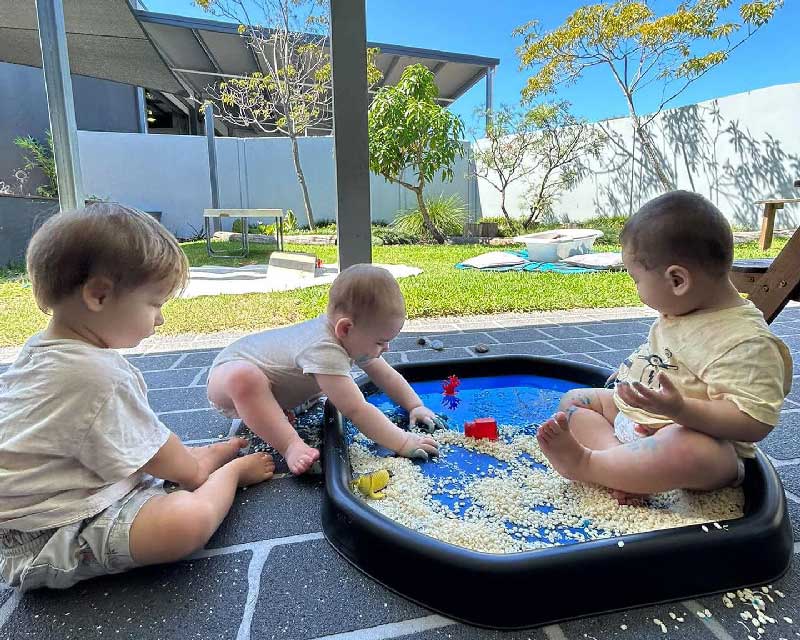
Jump into sensory fun with Petit Early Learning Journey
Are you seeking a holistic early childhood education and care service that inspires a child-led, inquiry-based learning program? At Petit ELJ, every day is different. We listen to children’s needs and interests to lead their play and learning.
We believe in having close partnerships with families as you are your child’s first educators. Tour your nearest Petit ELJ centre and discuss your child’s needs with our caring centre leadership team. We’re always here to help.
